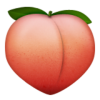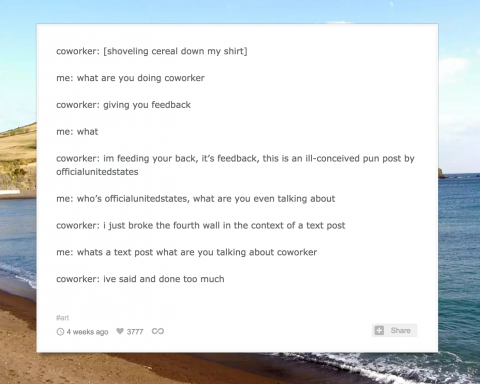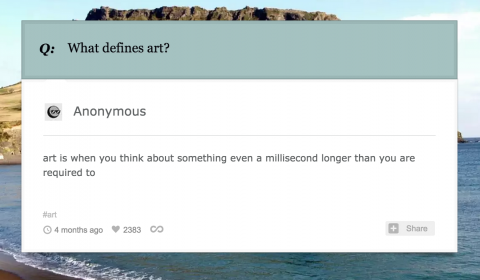September 30, 2015 - 19:16

“it is at this point that the peculiar question of the value of art arose. for the mimetic theory, by its very terms, challenges art to justify itself.”
“art is useful, after all, aristotle counters, medicinally useful in that it arouses and purges dangerous emotions.”
“the fact is, all western consciousness of and reflection upon art have remained within the confines staked out by the greek theory of art as mimesis or representation. it is through this theory that art as such— above and beyond given works of art—becomes problematic, in need of defense. and it is the defense of art which gives birth to the odd vision by which something we have learned to call “form” is separated off from something we have learned to call “content,” and to the well-intentioned move which makes content essential and form accessory”
“whatever it may have been in the past, the idea of content is today mainly a hindrance, a nuisance…”
first, i wish to define art. theorists have been attempting to do this at least since greek philosophers, so i know this isn’t a simple task. art is, i believe, a concept often put forth in a form of media such as language or visuals. it is not something inherently beautiful or painterly, or writerly, or any other abstract concepts we might have attempted to attach to it.
i find myself contemplating art as I scroll through tumblr (a website I use a lot for some damn reason)[1]. i listen to music, view images meant to stand alone and others with captions that add something to the visual… but it also has an array of ironic, post-ironic, humor, and anti-humor posts and blogs. for example, below as a screenshot from a blog with the user handle “officialunitedstates”. i use screenshots instead of text to keep the web framing of the art, which can be important to the understanding or intention of a piece. however, i also caption the image with the text that is important to the context of this paper.

coworker: [shoveling cereal down my shirt] me: what are you doing coworker coworker: giving you feedback me: what coworker: im feeding your back, it’s feedback, this is an ill-conceived pun post by officialunitedstates me: who’s officialunitedstates, what are you even talking about coworker: i just broke the fourth wall in the context of a text post me: whats a text post what are you talking about coworker coworker: ive said and done too much |
sometimes i find posts on the site beautiful, or intriguing, or amusing, or boring, or overused depending on the format. but i came across a post, originally published on the same anti-humor blog, that is especially intriguing.

anonymous asks, "what defines art?" officialunitedstates responds, "art is when you think about something even a millisecond longer than you are required to" |
while the post may or may not be ironic, i’ve really come to accept this definition of art (making, then, the post itself a thing of art).
now, i primarily use art in this piece to refer to visual art. this is not to put emphasis on visual art over other forms, but instead to simplify the scale of possible definitions and infinite interpretations.
art conceived to have “content” and to “say” something can be valuable. i think in this vein we should appreciate what the art’s purpose and intention is, and also the effects of the art on the artist and the viewer.
many individuals use art as a mode to interact with abstract concepts, thoughts, and experiences that are difficult to articulate in other forms.
but pieces without a specific intended “content”, such as with many abstract creations, both creating and viewing a piece brings forth an array of feelings, opinions, thoughts, experiences, and histories, as art does not exist in a vacuum. thus, even pieces without a direct content are representational articulations of the feelings and thoughts the piece provokes.
“the images in citizen were intended to work in a similar way. i was attracted to images engaged in conversation with an incoherence, to use your word, in the world. they were placed in the text where i thought silence was needed, but i wasn’t interested in making the silence feel empty or effortless the way a blank page would.” -- rankine, on her use of visual art in her book/poem, citizen.
i find myself at odds with susan sontag's piece, "against interpretation" (whose quotations are presented without comment at the beginning of this text). i agree that not all art has to be interpreted or justified. but her argument against interpretation, i think, goes against the art i have myself used.
consider this -- museums are often quiet spaces. a gallery invites the viewer to view and consider the work, and thus the environment is often kept as quiet as possible. but art, if it is inherently an articulation, cannot be silent. even if art is intended to create a silence, as with claudia rankine’s use of visual art in citizen, then her intent is still to articulate a silence. and while galleries, even the one her poem creates in its own paper-bound space, are often meant to be revered in silence, are not silent in the range of emotions, thoughts, feelings, and experiences called forth by a piece.
rankine believes that she creates silence with the use of her images. however, the reader (or viewer, as the case may be with the images) is then trying to see what the art is trying to “say”. rankine might then agree with sontag – that trying to interpret a content, whether present or not, is a “nuisance” to her use of art within her poem. but i want to problematize this notion with one that sontag herself brings up: that art does not have to be “challenged” to “justify itself”.
in a previous essay of mine, “trigger warning: s i l e n c e”, i place art throughout the text. this art functions however the reader of the piece interprets it. i cannot wholly dictate the audience’s reactions to the piece. my intent was to give visual examples of something that, while can be articulated through words somewhat, is exploded with feelings, emotions, and experiences that are not articulated in the same way through words. this idea is present both in the comic and the poem i put in my piece.
the poem i wrote, while revealing in simply what is literally written, requires some interpretation in order to truly get out of it all of the potential things i could be saying – and, in fact, the piece is meant to be interpreted, as i explicitly do not articulate some of the trauma i have experienced, but allude to it for the reader to gather.
sontag says that, before theory, art was defined as “what it did”. so by both my proposed definition and her idealized definition, art’s function is, simply, to exist and do whatever art does. the effects that art has on people do not need to be justified. if the audience poses to question the art, to interpret, to experience the art in whatever ways happen, then art is functioning just as it is supposed to.
given that art is, an articulation or embodiment of a set of emotions, thoughts, and experiences -- an embodiment that differs amongst people and changes over time -- art's relation to silence goes beyond rankine's use. art, be it the creation or the consumption of it, is articulation and thus, the opposite of silence.
[1] i say this only somewhat tongue-in-cheek. i use the website as a way to relax, to learn in short, manageable bursts, to connect to various communities, and to engage with certain modes of thinking i might otherwise not. it is a way to semi-anonymously connect, share thoughts, etc. however, it also has somewhat of a subculture, which means that it is often repetitive if not outright unhelpful and harmful. it is a huge time-waste more often than not.

Comments
deflecting the blow?
Submitted by Anne Dalke on October 11, 2015 - 13:36 Permalink
rb.richx—
In your first web event, you presented visual art as picturing, and so ending, silence. Here you think further about that position, and do so by neatly juxtaposing the claim of officialunitedstates—“art is when you think about something even a millisecond longer than you are required to”—against Susan Sontag’s principled refusal to interpret art. You end by refusing her reading, claiming that art is articulation, that it actually insists on interpretation (and so, to loop back to your first piece, refuses silence).
I’d invite you to spend some more time with Sontag, in part because I think your position may closer to hers than you acknowledge. She, too, thinks that art speaks, and speaks directly; but I think that what she’s cautioning against is our defending ourselves against this speaking, deflecting its immediacy by surrounding it with our own words, our own projections. I think the heart of her piece (or: the part that speaks some convincingly to me!) is this:
Real art has the capacity to make us nervous. By reducing the work of art to its content and then interpreting that, one tames the work of art. Interpretation makes art manageable, comformable....
When we engage in interpretation, in other words, we are shielding ourselves from the force of art itself. Deflecting the blow. In your language, maybe, refusing its articulation? Sontag says, further
interpretation is the revenge of the intellect upon art. Even more. It is the revenge of the intellect upon the world. To interpret is to impoverish, to deplete the world--in order to set up a shadow world of 'meanings.' It is to turn the world into this world. ('This world'! As if there were any other.)
What matters...is the pure, untranslatable, sensuous immediacy of some...images....It is always the case that interpretation...indicates a dissatisfaction (conscious or unconscious) with the work, a wish to replace it by something else.
Interpretation...violates art. It makes art into an article for use, for arrangement into a mental scheme of categories.... Interpretation takes the sensory experience of the work of art for granted, and proceeds from there. This cannot be taken for granted, now..... All the conditions of modern life--its material plentitude, its sheer crowdedness--conjoin to dull our sensory faculties...
What is important now is to recover our senses. We must learn to see more, to hear more, to feel more.
And “thinking more” might not necessarily be the way to do this?
Here’s another angle: the online etymology dictionary says that ‘art’ comes from the root *ar- " meaning “fit together,” or “join.” So maybe art is fundamentally about the act of making (rather than about interpreting what is made?) “Art” also the same word (okay, different root, but the word play here is just lovely!) as the second person present indicative of “be” (as in, thou “art” an intellectual. Or an artist….;)